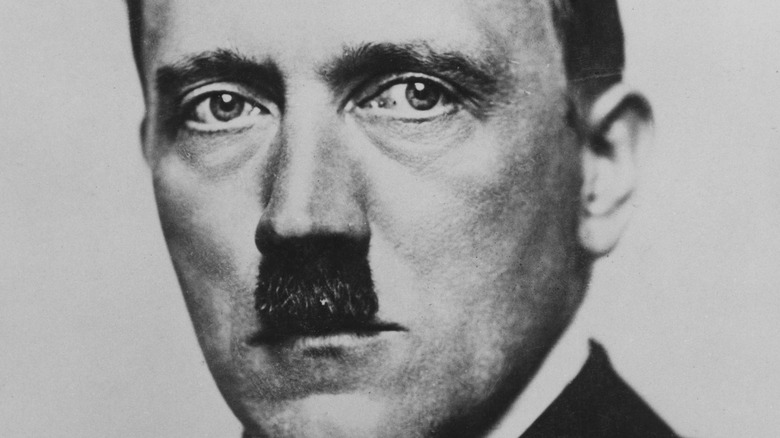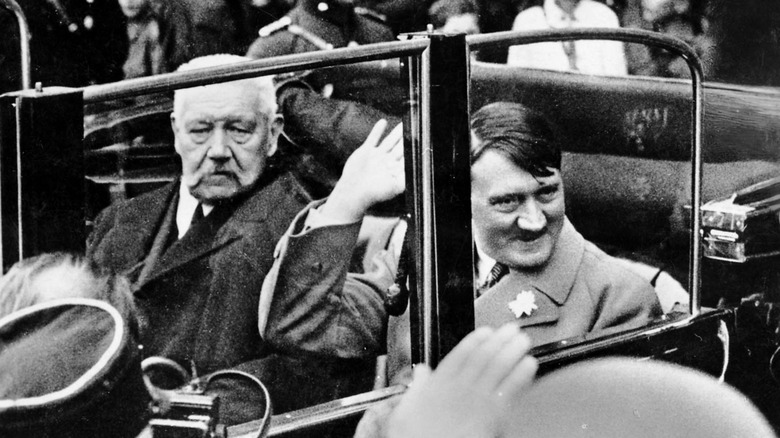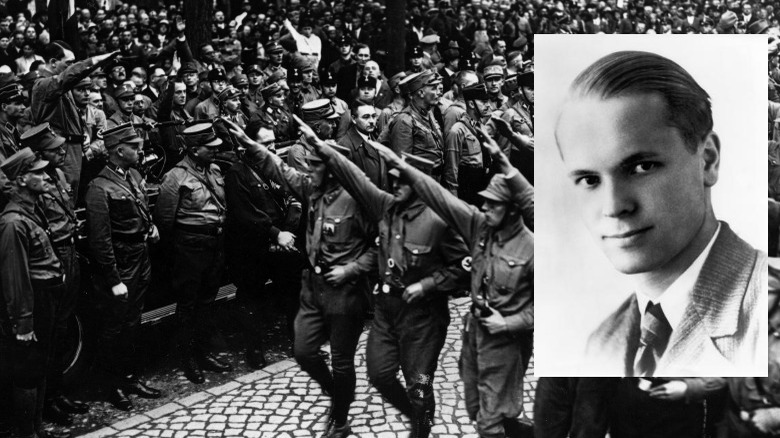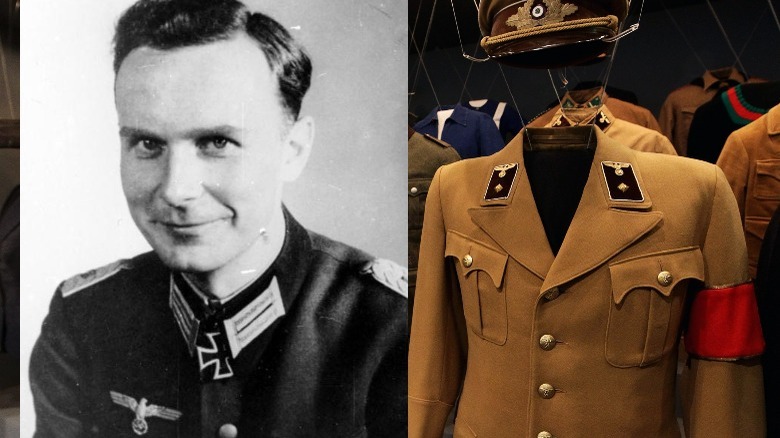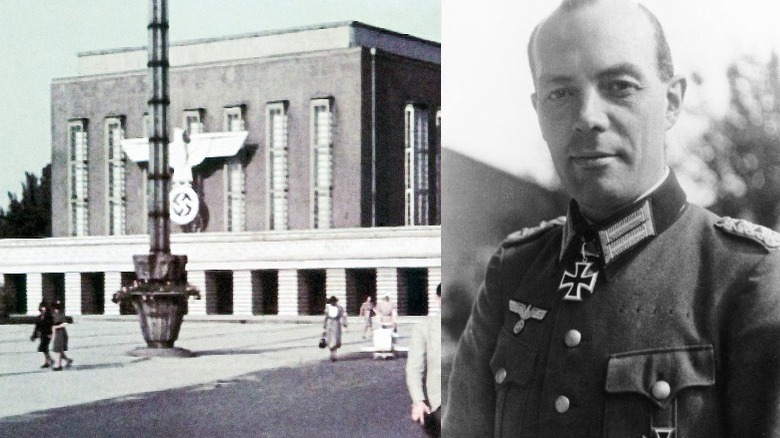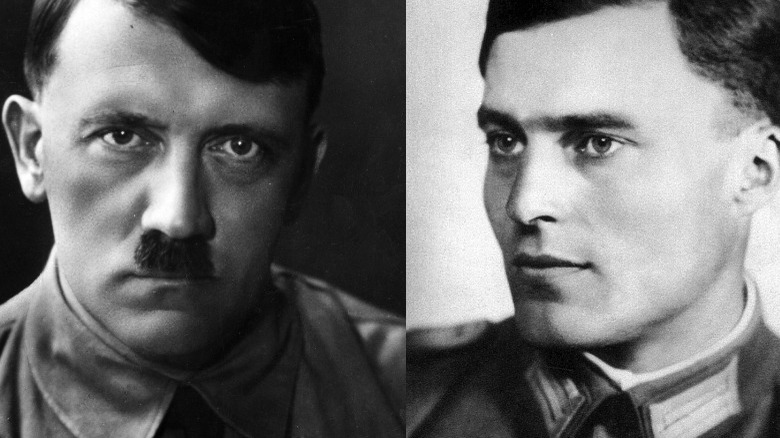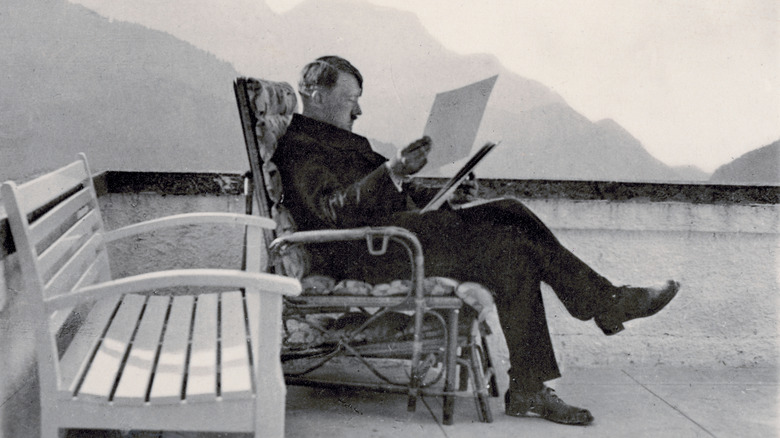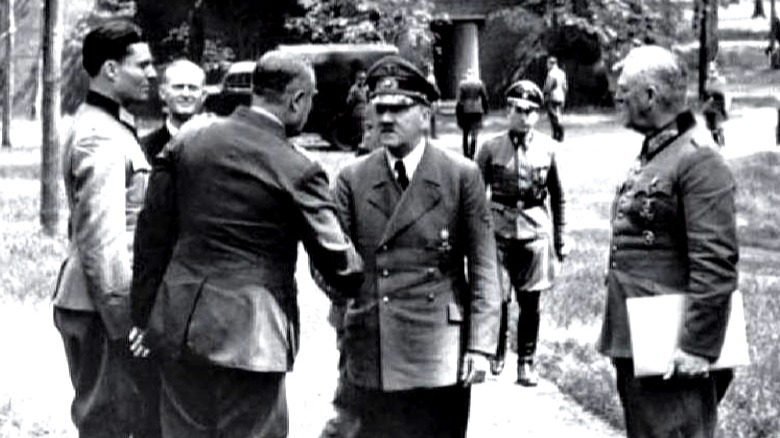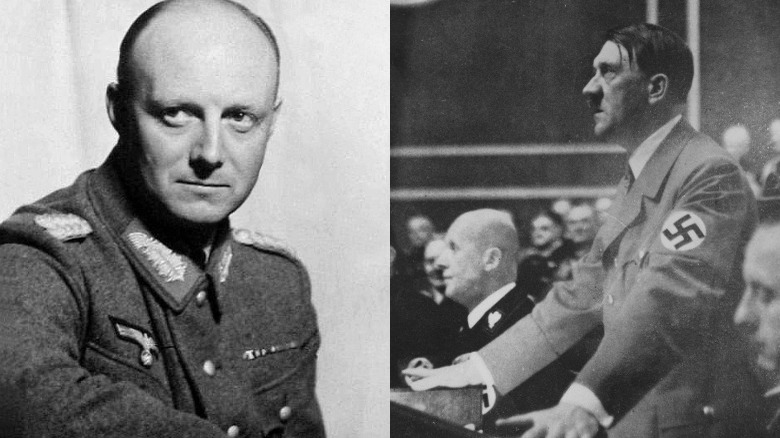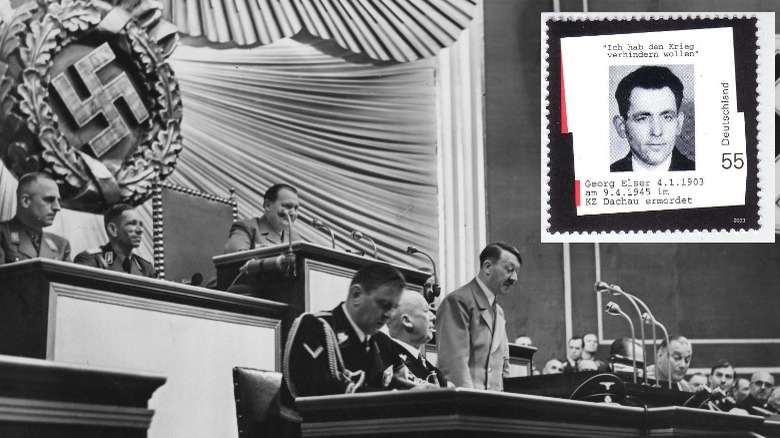The Truth About The Over 40 Assassination Attempts On Hitler
The sheer scale of what was going on in Germany in the 1930s and 40s is nothing short of mind-numbing. Numbers are so high that it's truly hard to grasp what was happening, and living through it? That's even more unimaginable. Let's take this terrible little truth nugget, which comes courtesy of the United States Holocaust Museum. Starting in 1933 and finally coming to a long-deserved end in 1945, Nazi movers and shakers built more than 44,000 concentration, detention, prison, slave labor, and extermination camps across the territories held by the Third Reich.
44,000. Just let that sink in.
Nazis hated so many people for so many reasons that unless you were a specimen of the blond-haired, blue-eyed Aryan ideal, you were probably on at least one of their lists. And that brings up an important question: How the heck was the driver of the Nazi war machine allowed to keep sucking wind for so long? It wasn't, it turns out, for lack of trying. Adolf Hitler died by suicide on April 30, 1945, but Sky History says that before then, he survived at least 42 assassination attempts. 42! How were people — including other Nazis — so bad at killing Hitler?
The assassination attempts started long before WWII
One of the biggest questions humankind needs to ask itself when looking at someone like Adolf Hitler is: "How the heck was this allowed to happen?" It's complicated, but according to The National WWII Museum, Hitler first rose through the ranks of Germany's Nazi party, then was made chancellor in 1933. By that time, War History Online says that there had already been seven serious assassination attempts made on his life. They started way back in 1921, when an unidentified gunman opened fire during one of his speeches. The same thing happened twice in 1923, and he was shot at again — on four separate occasions — in 1932.
There was one attempt in 1930 that took some serious pre-planning, and it involved poisoning. Hitler and his cronies were known to regularly eat at Berlin's Hotel Kaiserhof, and after one meal, literally everyone got sick. It's not clear what happened, and no one was ever arrested in connection with the mass poisoning, but it's thought the vegetarian Hitler escaped serious illness because of his dietary preferences.
For the rest of his reign, he employed food tasters ... although "employed" isn't quite right. Margot Woelk was one of 15 girls drafted into civilian service then put to work taste-testing the Fuhrer's food ... just in case someone tried to poison him again. She was the only one to survive: The others were killed by the Soviets (via CBS News).
Some ended with the execution of a would-be assassin
Perhaps predictably, some of the failed assassination attempts went poorly for the would-be assassins. Helmut Hirsch had been a member of the Jungenschaft before it was dissolved on orders from the Nazi regime and ended up joining a group called the Black Front. They, says Brandeis University, and splintered off from the Nazis when the Nazis got a little too, well, Nazi-ish. Among their core beliefs was that they could rally the German people to overthrow Hitler and end the regime, and to those ends, Hirsch was convinced to carry a bomb into the Nurnberg building — not knowing it was a suicide mission. He was arrested first, though, and although the US ambassador tried to stop his execution, it was carried out in 1937.
In 1938 — just days before fanatical Nazi followers were given the go-ahead to kick off Kristallnacht, the night of widespread violence and destruction that legitimized the use of bloody force against certain groups — a Swiss student named Maurice Bavaud (pictured) tried to assassinate Adolf Hitler during a Munich parade. Switzerland — who stuck by their policy of neutrality — refused to intervene, and Bavaud was sent to the guillotine in 1941 (via NBC News).
Finally, there were people like Captain Josef "Beppo" Romer. He, says historian Peter Hoffman in the "History of the German Resistance," was involved in plotting assassination attempts between 1939 and 1942, and even though none were carried out, he was still arrested and executed as a conspirator.
Some volunteered to die in order to try to assassinate Hitler
Ewald-Heinrich von Kleist was one of several men who volunteered to go on a suicide mission to kill Adolf Hitler. He was from a wealthy Prussian (and anti-Nazi) family, and when he was approached by the famous Colonel Claus von Stauffenberg, he volunteered to be the one to put on a suicide vest to carry out the assassination. He was supposed to model new uniforms for the Fuhrer, and when that plan didn't work, he took part in the famous July 20 assassination attempt. When he died in 2013, CBS says he was the last surviving member of the plot.
Similarly, Axel von dem Bussche (pictured) volunteered to carry a pocket full of grenades with him when he was set to model new overcoats for Hitler. The so-called operation Overcoat never happened, and after losing a leg and most of his right hand in active combat, he stepped up again and also participated in von Stauffenberg's July 20 plot. (He survived, and according to The New York Times, he died of natural causes in 1993.)
Baron Rudolf-Christoph von Gersdorff, too, was a Nazi intelligence officer who volunteered to go on a suicide mission to kill Hitler. He carried a bomb with him while showing Hitler through the Zeughaus military museum, and he later explained his acceptance of the suicide mission (via Ozy): "I did not need much time to answer 'yes' to the most momentous question that anybody had ever asked me."
Some assassination attempts were foiled for bizarre reasons
Truth can definitely be stranger than fiction at times, and that's the case for some of the failed attempts on Hitler's life. Henning von Tresckow's name pops up a lot — not only did he recruit other would-be assassins like Rudolf-Christoph von Gersdorff (via the Jewish Virtual Library) — but he also had his own plans. One involved asking a fellow military officer — who just happened to be traveling with Adolf Hitler — if he could take a case of Cointreau with him when they flew back from the Eastern Front. Packed in with the alcohol was a bomb and a detonator, but Tresckow forgot about the cold: The detonator froze and malfunctioned (via The Drinks Business).
In 1937, there were plans to assassinate Hitler as he gave a speech in Berlin, only this time, the detonator failed to go off for a different reason: War History Online says the German soldier who was supposed to set it off was accidentally locked in the bathroom, and missed his window of opportunity.
Strangest of all, it was the Allies who foiled one assassination attempt. Axel von dem Bussche was all ready to go: He'd gotten a bomb, and was prepared to sacrifice his own life to set it off as he modeled the Nazi's new coats for Hitler. The meeting never happened, though, because the day before the suicide mission was going to take place, Allied bombers destroyed the train that was transporting the new uniforms (via The Washington Post).
Some assassination attempts missed by the narrowest of margins
"Close only counts in horseshoes and hand grenades" isn't actually true. Rudolf-Christoph von Gersdorff (pictured) decided all this needed to come to an end after he heard about the massacre of the Jewish ghetto of Borisov, so he put a bomb in his pocket in preparation for giving Adolf Hitler a museum tour.
According to Ozy, the bomb operated with a delayed switch. Once Gersdorff flipped it, it would take between 15 and 20 minutes for the acid to dissolve some of the components and trigger the bomb. That meant he had to keep Hitler entertained for that long: The planned tour took half an hour, but when Hitler rushed through the whole thing in way less than that, it gave Gersdorff just enough time to wave goodbye, then run for the bathroom — where he flushed the literal ticking time bomb down the toilet.
Georg Elser, too, missed by a matter of minutes. History Extra says he was acting alone when he hatched a plan to teach himself how to build a bomb, which he would plant in the walls of Munich beer hall — a beer hall that he knew Hitler was going to visit in celebration of his famous 1923 Beer Hall Putsch. The bomb would injure more than 60 people and ultimately kill eight, but it exploded just 13 minutes after Hitler wrapped up his speech and left. Elser would be arrested, sent to Dachau, and executed.
The July Plot
One of the most famous assassination attempts was the one given the code name Operation Valkyrie. Strangely, though, it the plan to carry bombs into Adolf Hitler's inner chambers at the East Prussian Wolf's Lair, put them under a table, and let the explosives do their thing wasn't even a first choice — according to the United States Holocaust Memorial Museum, it was a contingency plan to fall back on if other ideas didn't work.
They didn't — and neither did Operation Valkyrie, for a few reasons. For starters, Claus von Stauffenberg (pictured, right) only managed to arm one of the two bombs. The one that did get prepped — and did ultimately detonate — had been moved, and had much of its blast blocked by heavy table supports. After the blast, they were completely convinced that it had worked. Cutting power and communications to the Wolf's Lair, they went about the rest of their plan to arrest Hitler's closest associates and install a new government.
What really happened demonstrates pretty perfectly why it's always important to check for a corpse. Hitler was very much alive, and the fallout was very fast and very wide. There were only a handful of key conspirators, but by the time the smoke had cleared, more than 7,000 were arrested for their often imagined role in the plot. Of those, nearly 5,000 were executed.
Operation Foxley
World War II wasn't as black-and-white as it might seem at a glance, and according to the BBC, it was the Germans themselves who made the most attempts to get rid of Adolf Hitler in an assassination sort of way. There was, however, one plan hatched by the British Special Operations Executive with the goal of taking him out with a single bullet, and it was called Operation Foxley.
That wasn't always how the plan was going to go, though, and according to War History Online, the Allies first looked at the logistics of things like bombing his personal train. That proved too complicated, and the answer came when one of Hitler's personal guards was captured and questioned alongside the D-Day landings. That's when they learned that any time Hitler was staying at his home at Berchtesgaden, he liked to take a 10-minute walk from the main house to the tea house, where he would have breakfast. The Brits got the lay of the land, chose their snipers, and even made contact with a few inside agents.
Literally everything was in place, and when the plan was submitted for the final go-ahead, Allied officials stopped it. Why? Not only did they not want to turn Hitler into a martyr of a mythical scale, but they realized that he was such a bad military strategist that if someone more competent were to replace him, ending the war would be even harder.
Would-be assassins weren't all taking the moral high ground
It's easy to assume that anyone who wanted to take out Adolf Hitler was doing so because they wanted to put an end to things like the concentration camps, but it's not that straightforward. For some — like Rudolf-Christoph von Gersdorff — that was probably part of it. In his memoir, he would write (via Ozy) that he had always viewed Hitler as "mentally abnormal," and got fully on board with giving his own life in an assassination attempt after hearing about the massacre of 15,000 Jewish men, women, and children at the Borisov ghetto in Belarus. So many — mostly children — were buried alive that the earth was said to be "breathing" for hours, until it wasn't.
Still, according to the United States Holocaust Memorial Museum, even the motivations of the men involved in planning the July 20 attack are uncertain. While yes, some objected to the anti-Jewish policies, others were more concerned about Hitler running Germany right into the ground. Take Operation Valkyrie's Colonel Claus von Stauffenberg, for example. His son Berthold explained his motivations to the BBC, saying that while he had supported "Nazi policies," he was also "disenchanted with Hitler's strategic capabilities and that really, Hitler was a different type of person from what we thought acceptable."
Simply put, the Holocaust Museum puts it this way: "[Many wanted] to rescue Germany from catastrophic defeat brought about by Hitler's increasingly irrational management of the war."
Why are some of these attempts so elaborate?
So here's a question: He gave a lot of speeches, why not just pick up a sniper rifle and be done with it? When The Drinks Business looked at Major General Henning von Tresckow's (pictured) attempt to blow up Adolf Hitler's plane with a bomb smuggled aboard in a case of Cointreau, they pointed out that he believed killing Hitler was just the beginning. That's why they called it Operation Spark, in hopes that his death would cause Germany to sit up, take notice, and get rid of the Nazis.
It was General von Kluge who said they couldn't just shoot Hitler, because someone — like Heinrich Himmler — would just pick up where Hitler left off.
British historian Roger Moorhouse says that there was a very good reason for thinking that would have happened. He explained to History Extra that it went back to the foundation the Nazi party had been built on, and that was the idea that after World War I, Germany had been undermined by "a shadowy cabal of Jews and socialists," bringing about their fall from the top of the food chain as a world power. That was the idea that had gotten scores of Germans on board with the whole Nazi thing in the first place, and not only would Hitler's assassination been used to promote that idea, but it would have set up room for someone to just have stepped right into the title of Fuhrer and kept on going.
Heroes... with families treated as traitors
In hindsight, the idea of someone wanting to give their life to take off the head of the Third Reich for good makes them a hero. That definitely wasn't always the case, though, as the son of one of Operation Valkyrie's key players told Newsweek.
After the bombing of Hitler's headquarters failed to kill him, most of the conspirators were arrested and executed. That included Gunther Smend, who was hung from a meat hook in Plotzensee prison and left there to die. He left behind his 26-year-old wife and their three children, including four-month-old Axel. Life was not easy for them.
Renate Smend learned that her husband was dead when she received a package in the mail. The delivery contained his notebook, his wedding ring, and a bill — she was being charged for his execution. Now labeled a "traitor widow," she and her family were shunned by neighbors and former friends, while Axel remembered that even his teachers looked down on him. At a parent-teacher conference called because of his poor math scores, he was told, "... it's no surprise that he's bad at maths. He's the son of a traitor."
The morality of assassination attempts
Today, we can look at Hitler's rise to power and we know exactly how this is all going to turn out. We're not surprised that people tried to kill him as early as the 1920s, but interestingly, philosophers have argued that men like Georg Elser (pictured, inset) — who tried to kill Hitler in 1939, before his invasion of France — weren't taking the moral high ground after all.
Janna Thompson, a philosophy professor at La Trobe University, says (via The Conversation) that the question actually gets pretty tricky. Some — like Hannah Arendt Institute for Research on Totalitarianism philosopher Lothar Fritze — suggest that lauding Elser's attempt to take out Hitler may encourage present-day terrorist attacks. Thompson explains: "Moral judgement should not be based on knowledge that comes from hindsight."
That least to another moral question: If you could go back in time to kill Baby Hitler, would you? The easy, at-a-glance answer is, "Yes, of course!" But Vox argues that it's not that simple. Not only is no one really sure how this whole time-travel thing would work, and while it's tempting to think that killing Hitler would have averted the Holocaust, it's entirely possible that the new history is even worse. What if the "new" Hitler that rose to fill the power vacuum left by the old one was a brilliant tactician who got nuclear weapons first, wiped out half the planet, and ruled over the rest with an iron fist? It's food for thought.
